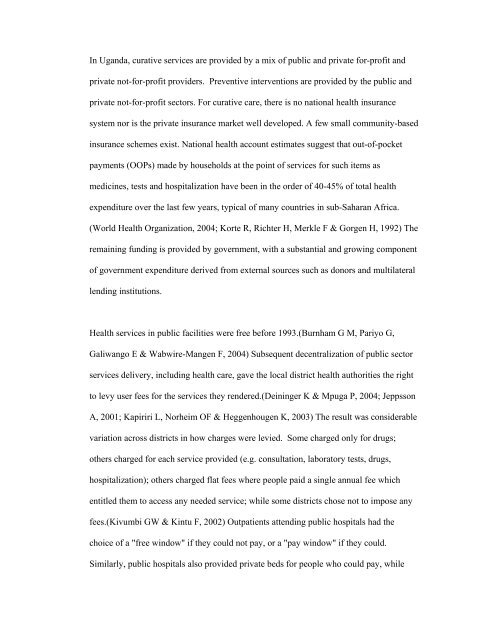The elimination of user fees in Uganda - World Health Organization
The elimination of user fees in Uganda - World Health Organization
The elimination of user fees in Uganda - World Health Organization
Create successful ePaper yourself
Turn your PDF publications into a flip-book with our unique Google optimized e-Paper software.
In <strong>Uganda</strong>, curative services are provided by a mix <strong>of</strong> public and private for-pr<strong>of</strong>it andprivate not-for-pr<strong>of</strong>it providers. Preventive <strong>in</strong>terventions are provided by the public andprivate not-for-pr<strong>of</strong>it sectors. For curative care, there is no national health <strong>in</strong>surancesystem nor is the private <strong>in</strong>surance market well developed. A few small community-based<strong>in</strong>surance schemes exist. National health account estimates suggest that out-<strong>of</strong>-pocketpayments (OOPs) made by households at the po<strong>in</strong>t <strong>of</strong> services for such items asmedic<strong>in</strong>es, tests and hospitalization have been <strong>in</strong> the order <strong>of</strong> 40-45% <strong>of</strong> total healthexpenditure over the last few years, typical <strong>of</strong> many countries <strong>in</strong> sub-Saharan Africa.(<strong>World</strong> <strong>Health</strong> <strong>Organization</strong>, 2004; Korte R, Richter H, Merkle F & Gorgen H, 1992) <strong>The</strong>rema<strong>in</strong><strong>in</strong>g fund<strong>in</strong>g is provided by government, with a substantial and grow<strong>in</strong>g component<strong>of</strong> government expenditure derived from external sources such as donors and multilaterallend<strong>in</strong>g <strong>in</strong>stitutions.<strong>Health</strong> services <strong>in</strong> public facilities were free before 1993.(Burnham G M, Pariyo G,Galiwango E & Wabwire-Mangen F, 2004) Subsequent decentralization <strong>of</strong> public sectorservices delivery, <strong>in</strong>clud<strong>in</strong>g health care, gave the local district health authorities the rightto levy <strong>user</strong> <strong>fees</strong> for the services they rendered.(De<strong>in</strong><strong>in</strong>ger K & Mpuga P, 2004; JeppssonA, 2001; Kapiriri L, Norheim OF & Heggenhougen K, 2003) <strong>The</strong> result was considerablevariation across districts <strong>in</strong> how charges were levied. Some charged only for drugs;others charged for each service provided (e.g. consultation, laboratory tests, drugs,hospitalization); others charged flat <strong>fees</strong> where people paid a s<strong>in</strong>gle annual fee whichentitled them to access any needed service; while some districts chose not to impose any<strong>fees</strong>.(Kivumbi GW & K<strong>in</strong>tu F, 2002) Outpatients attend<strong>in</strong>g public hospitals had thechoice <strong>of</strong> a "free w<strong>in</strong>dow" if they could not pay, or a "pay w<strong>in</strong>dow" if they could.Similarly, public hospitals also provided private beds for people who could pay, while
















